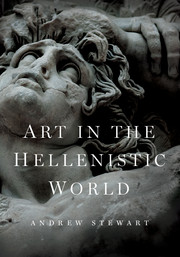Book contents
- Frontmatter
- Contents
- List of Illustrations
- Preface
- Introduction
- 1 Settlement
- 2 Power
- 3 Victory
- 4 Benefaction
- Focus I The Great Altar of Pergamon
- Focus II Hellenistic Mosaics
- Appendix A The Artist
- Appendix B Kallixeinos of Rhodes on the Wonders of Alexandria
- Glossary
- Timeline
- Biographical Sketches
- Select Bibliography and Further Reading
- References
- Sources of Illustrations
- Index
Focus II - Hellenistic Mosaics
Published online by Cambridge University Press: 05 October 2014
- Frontmatter
- Contents
- List of Illustrations
- Preface
- Introduction
- 1 Settlement
- 2 Power
- 3 Victory
- 4 Benefaction
- Focus I The Great Altar of Pergamon
- Focus II Hellenistic Mosaics
- Appendix A The Artist
- Appendix B Kallixeinos of Rhodes on the Wonders of Alexandria
- Glossary
- Timeline
- Biographical Sketches
- Select Bibliography and Further Reading
- References
- Sources of Illustrations
- Index
Summary
Because most Hellenistic painting is lost, and what remains is mostly funerary and uneven in quality and distribution, mosaics constitute the only surviving, high-quality pictorial corpus that can stand comparison with its best sculpture (see, for example, Focus I: “The Great Altar”). Moreover, although mosaic production in the Greek world predated the Hellenistic age by a century, only during this period did two key techniques reach their apogee, namely, pebble and tessellated mosaic: reason enough for a focused study.
MACEDON: THE MATURITY OF PEBBLE MOSAIC
Although many pebble mosaics have been recovered from Macedonian palaces and houses, two roughly contemporary sets at Pella, dated to the last quarter of the fourth century, justly stand at the forefront of the art. Both houses, which – excluding their upper floors – cover a staggering area of 25,300 and 32,300 square feet (2,350 and 3,000 square meters), are better called luxury mansions and must have belonged to elite – probably military – families massively enriched by Alexander’s conquests. Only the Macedonian royal palaces at Pella and Vergina surpass them in size.
- Type
- Chapter
- Information
- Art in the Hellenistic WorldAn Introduction, pp. 197 - 205Publisher: Cambridge University PressPrint publication year: 2014



